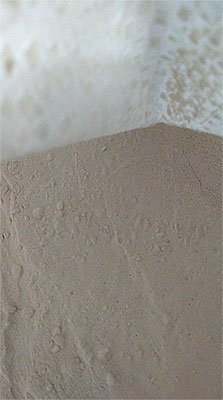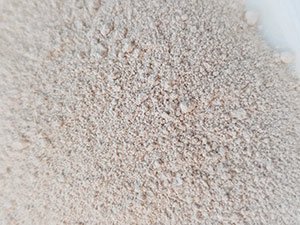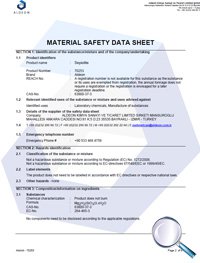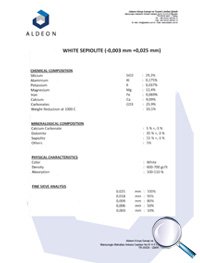
Sepiolite
 Sepiolite, price Sepiolite is a porous fibrous mineral, also known as “foam”. Named for the similarity with the calcareous dorsal shell of the cuttlefish (Latin: sepia). The term “sepiolit” coined the German mineralogist EF Glocker (Ernst Friedrich Glocker), who described the mineral in 1847.
Sepiolite, price Sepiolite is a porous fibrous mineral, also known as “foam”. Named for the similarity with the calcareous dorsal shell of the cuttlefish (Latin: sepia). The term “sepiolit” coined the German mineralogist EF Glocker (Ernst Friedrich Glocker), who described the mineral in 1847.
The composition is Mg4 [Si6O15] (OH) 2 • 6H2O. Rhombic syngony. Characteristic impurities: aluminum, calcium, iron, nickel. It is found mainly in compact masses, representing cork-shaped aggregates up to 20 cm in size.
Colour: usually white, greyish, light yellow; sometimes with a brown, greenish or reddish tinge. Opaque. Gloss: silky, dull, matte. Refractive indices: 1,520 - 1,530 (max. Birefringence - 0,010).
Fragile. Hardness: 2. The average specific weight is 2.1 g / cm3. Sepiolite most of all resembles a sponge with its porous structure. The specific weight of this mineral is twice as high as that of water, but due to its porous structure, dry sea foam does not sink in water.
High porosity and low density make sepiolite a unique natural, environmentally friendly absorbent. Sea foam can be successfully used both for cleaning the water surface from oil products, and as a cat litter. Like palygorskite similar in composition and properties, sepiolite is used as a heat insulator, as well as in the production of building mixtures.
AGRARIAN SECTOR
SEPIOLIT found wide use in agriculture.
Used in the production of feed and premix as a sorbent of mycotoxins. Sepiolit qualitatively improves the health of the digestive system of animals. It is a good absorber of mycotoxins and heavy metals.
It is used as an improver for fertilizer properties and a pesticide carrier.
Used as an absorbent in pet litter.
Also as an absorber of ammonia gases on livestock farms.
 Sepiolite is registered as a technological additive E-562 in the functional group of binders and anti-caking agents in accordance with CE regulation 1831/2003. Sepiolite was authorized by the European Union in 1990 for use as a technological additive for animal feed and was used because in all production processes of the food industry.
Sepiolite is registered as a technological additive E-562 in the functional group of binders and anti-caking agents in accordance with CE regulation 1831/2003. Sepiolite was authorized by the European Union in 1990 for use as a technological additive for animal feed and was used because in all production processes of the food industry.
Sepiolite has been widely used to filter and clarify industrial oils and waxes.
Regeneration of industrial oils. In the production of paraffins and waxes and soaps.
Sepiolite can also be used to filter and clarify essential oils such as sunflower, rapeseed, soybean oil, palm oil and olive oil.
At present, bleaching lands are widely used in the production of biodiesel and biogas. Sepiolite can also be used in the filtration of animal fats, which also have great prospects in the production of biodiesel.
INDUSTRIAL SECTOR
Sepiolite has been widely used to filter and clarify industrial oils and waxes.
Regeneration of industrial oils. In the production of paraffins and waxes and soaps.
Sepiolite can also be used to filter and clarify essential oils such as sunflower, rapeseed, soybean oil, palm oil and olive oil.
Sepiolite is used to seal household waste landfills.
The adsorption properties of Sepiolite are actively kept from penetrating into the soil and water of heavy metals and radioactive substances.
Also in the properties of Sepiolite is not unimportant for industrial landfills property is the absorption and binding of undesirable odors. This is especially important for landfill livestock sites.
It is used as a moisture regulator in the production of building mixtures and cements.
It can also be used to remove oil and oil contaminants on the soil surface and water as an ecological sorbent.,
 |
 |
